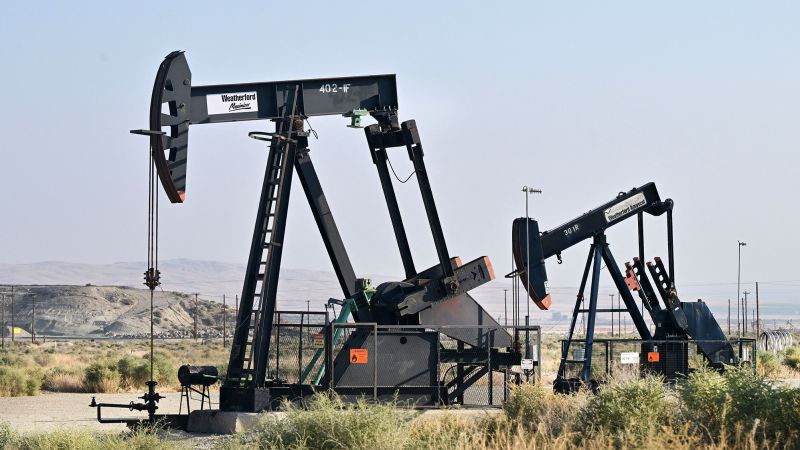Global energy prices are finishing the week the way they started — shooting higher as a cocktail of risks to supply have put investors on edge.
The price of Brent crude, the global oil benchmark, rose more than 4% Friday to trade at nearly $90 a barrel. West Texas Intermediate crude oil futures, the US benchmark, jumped 4.2% to $86 a barrel.
The main driver, according to Edward Moya, a senior market analyst at Oanda, is the unfolding conflict in Israel, and fears that it could spill over into the wider oil-rich Middle East region.
“The oil market is very sensitive to developments with the Israel-Hamas war,” he told CNN. “There are fears that, even as we see US production hit record levels, we could see a major shock to supplies in the near future.”
Analysts told CNN earlier this week that the war — sparked by a deadly assault by Hamas militants over the weekend — had made investors wary of a potential escalation that could embroil Iran.
Israel has long accused Iran of engaging in a form of proxy war by backing groups — including Hamas — that have launched attacks against it. Tehran has denied involvement in the weekend’s attacks.
But if a clear link to Iran emerges, analysts said, some kind of an intervention by the United States cannot be ruled out. That would likely entail tighter enforcement of existing sanctions on Iran’s oil exports.
Israel has warned 1.1 million people in Hamas-controlled Gaza to move south, and has called up 300,000 reservists ahead of a potential ground invasion. The Israel Defense Forces have also sent more troops to the country’s northern border with Lebanon to counter any potential attack by militants of Hezbollah, another group Iran has backed.
“Difficult to assess how an escalation will unfold. I think that what’s really driving the fears is a direct conflict with Iran, and [those fears] seem to grow by the day,” Moya said.
Brent is on course to finish the week 1.7% higher, a notable turnaround after it fell 11.3% last week, logging its biggest weekly drop since March.
Price rises this week put Brent back on course to top $90 a barrel, a level it last breached in early September following months of strengthening mainly on the back of production cuts by Saudi Arabia and Russia.
“Geopolitical situations such as these can change direction at short notice and have the ability to rattle markets and energy prices in a big way. Investors are wary of the unknown,” Sophie Lund-Yates, lead equity analyst at Hargreaves Lansdown, wrote in a note Friday.
New US measures, unveiled Thursday, aimed at making it harder for Russia to skirt a cap on the price of its oil set by the Group of Seven nations may also be driving oil prices higher as the effort could reduce supply.
The situation in Israel has also weighed heavily on the European natural gas market.
European benchmark gas futures jumped as much as 5.7% Friday to €56 ($59) per megawatt hour, before falling back slightly later in the day. Prices have risen 44% since Friday last week.
Massimo Di Odoardo, vice-president of gas and liquefied natural gas (LNG) research at Wood Mackenzie, told CNN that the temporary shuttering Monday of an Israeli gas field supplying gas to Egypt and Jordan, as well as to Israel’s power market, posed a real risk to Europe.
Egypt produces a lot of its own natural gas in addition to imports and processes some of it into LNG for shipping abroad. The country exports about 3 million metric tons (3.3 million tons) of LNG over the winter, with the majority heading to Europe, Di Odoardo said. If Egypt can’t import its usual amount of gas from Israel, that may result in fewer — or no — LNG exports.
“There’s a real risk that Egypt would not be able to export any cargo through the winter and this would eventually result in less gas available to Europe,” he said.
An announcement by US energy giant Chevron (CVX) Tuesday that workers at two key Australian LNG facilities planned to strike has also unsettled investors, according to Di Odoardo. So has the temporary closure of the Balticconnector, a gas pipeline linking Finland and Estonia, he added.
Authorities are investigating whether damage to part of the pipeline running under the Baltic Sea was the result of sabotage.
Reports of suspected sabotage have raised questions about the vulnerability of Europe’s critical infrastructure, just a little over a year after a series of explosions forced the closure of the vital Nord Stream 1 pipeline which had once ferried gas from Russia to Germany.
“This has obviously created a lot of nervousness and heightened the geopolitical risk within the European gas market,” Tomas Marzec-Manser, head of gas analytics at ICIS, told CNN.
Still, prices are far below their levels this time last year, when they hit €156 ($165) per megawatt hour, as Europe was just emerging from an energy crisis sparked by Russia’s war in Ukraine. And Marzec-Manser thinks Europe’s upcoming winter will be bearish for the gas market.
While demand is expected to rise as the weather turns colder, he said, “compared to historical rates, we expect consumption from the residential and industrial sector to remain quite muted” as gas prices remain high.
Read the full article here







